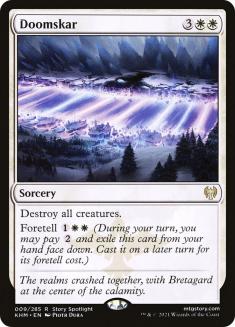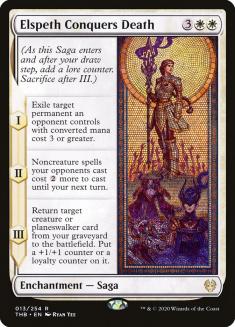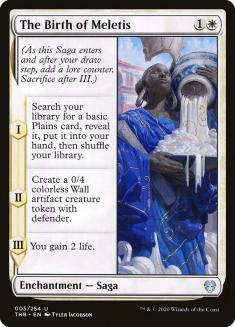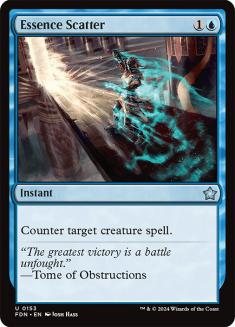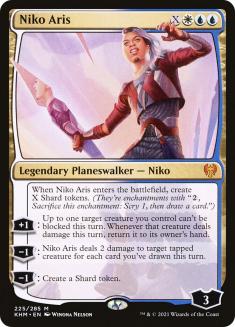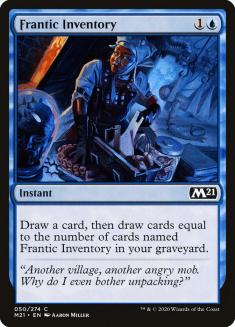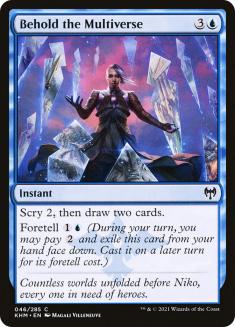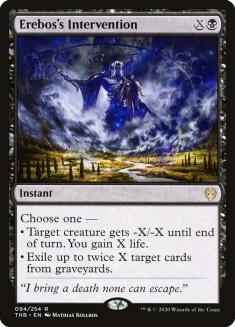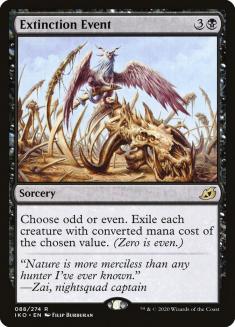Kaldheim Standard has not been as hostile to control decks as I anticipated. With the release of Doomskar, I assumed the aggressive decks would look to incorporate more resilient creatures, which has occurred. Boros Aggro decks summon an array of early threats, most of which have or grant the indestructible keyword. Although this is problematic for control decks centered around destroy, not exile, effects, the creatures are low-powered. A 1/1 that protects a creature here and a 3/1 that must tap to gain its resilience there have not sent me running for the hills just yet.
The existence of these Boros Aggro threats combined with Skyclave Shade has made life more problematic for traditional removal. Having access to black-based removal is a blessing for control players and a curse. Heartless Act and Eliminate are the best in the business; however, these aggressive elements of Kaldheim Standard can punish you if you enter the arena without some type of exile capability. Luckily for Esper Control, Extinction Event is still a staple in the 75.
Doomskar is by leaps and bounds the best sweeper control players have access to in Standard. Extinction Event is a powerful supplement to the Kaldheim all-star, but I do not believe it deserves a maindeck slot just yet. The Boros and black-based aggro players will be out there to punish you Game 1 for having the wrong sweeper, but the rest of the metagame folds to an old-fashioned “destroy all creatures” spell. Mono-Green Aggro, Dimir Rogues, Gruul Aggro, and any other combination of traditional creatures falls hard to the discounted sweeper. It’s not the earlier turn capability of Doomskar that makes it so powerful in Kaldheim Standard, but the ability to cast multiple spells on the same turn that it’s foretold.
Historically for control decks, the sweeper turn locks the controller completely out of mana resources. It’s a desperation play to clear the battlefield and give the opponent one turn of free rein. Doomskar has changed this dynamic, allowing a sweeper to go off on Turn 5 while holding a piece of disruption for the opponent’s next play. The viability of Doomskar is not affected by a bunch of resilient creatures that roam Standard. Destroying all creatures has a very high floor in all formats.
Sultai Ramp is the talk of the town in Kaldheim Standard. I have played it and understand the appeal of playing sweepers that exile, but I disagree with its place in competitive play. Sacrificing Elspeth Conquers Death and Doomskar is too high of a cost to attempt to call a metagame. There’s a point where the power level of cards is too high to ignore and that’s where we are with the current makeup of white-based control. Even though the removal of white pales in comparison to black, there is some hope with the one option it does have.
Glass Casket is the only true removal spell that white has in the early-game, but it does exactly what you want removal to do — exile a creature that was summoned in the first few turns of the game. The negative of this removal spell is clear: not being able to cast it at instant speed like its black-based counterparts. Watching helplessly as threats with flash enter the battlefield on Turn 2, or smack you with haste on their turn, is a frustrating experience. Heartless Act and Eliminate never let me down in those scenarios; however, the importance of exile may be just enough to make the black splash unneeded.
Creatures (2)
Planeswalkers (5)
Lands (23)
Spells (30)

This take on Azorius Control has given me high hopes for two-color control in Standard. It leans heavily on Doomskar, unlike its Esper Control counterpart, which can tango with any aggro early-game better than most. The lack of cheap, targeted removal increases the importance of having a sweeper ready to roll between Turn 3 and Turn 5. Even though the removal is weak, there are some supplemental spells that help stave off lethal damage before Doomskar arrives.
The Birth of Meletis has a natural home in Azorius Control, providing lifegain, a blocker, and vital land drops. I’m always looking for an excuse to get this sucker back in the lineup, but it often requires a bunch of basic Plains to have a chance. Esper Control, or any three-color control deck for that matter, is unable to pack a ton of basics in the deck to satisfy this card’s requirement. Azorius Control has a smooth manabase, especially with Hengegate Pathway, and The Birth of Meletis is an important step to guarantee a timely Doomskar cast.
The other support card is Essence Scatter. There’s one copy in the maindeck and the sideboard to assist the user with survival before Doomskar. It’s a fantastic card on the play but can be clunky on the draw. For this reason, I’m more comfortable having the second copy in the sideboard for those games where I know which player is going first.
I also have the third copy of The Birth of Meletis in the sideboard to help boost chances against the faster aggro decks that can attack you down before a sweeper can save you. When the third The Birth of Meletis comes in, a Jwari Disruption comes out. There are 29 lands in the deck, counting the modal DFCs and The Birth of Meletis, and I think that’s the perfect number. Cutting a land against aggro decks for an enchantment that guarantees a land is a sideboarding strategy I have used with success since it has been an option.
The rest of this Azorius Control deck mimics its Esper Control sibling. The counterspells, threats, planeswalkers, and general gameplan does not change. Outside of the manabase and a different-looking early-game, both control decks have similar play patterns and are both viable options.
For those fans of Esper Control, I have made significant changes to that deck since the last time we spoke.
Creatures (2)
Planeswalkers (6)
Lands (25)
Spells (27)

The key change that has influenced my control deckbuilding is the power of Niko Aris. I was hesitant at first, after recently being burned by Jace, Mirror Mage. Jace is still a strong source of card advantage on its surface; however, Standard was too volatile to give it a chance. We often saw it in the sideboard of successful control decks that brought it in against the slow decks of the format to defeat them on the battlefield of value. With the release of Niko Aris, we have that same warm card advantage feeling with a giant bonus.
When I first previewed Niko Aris, I said that the second ability would make or break it. If the damage to a tapped creature was helpful on Turn 3 against multiple decks in the format, Niko Aris would be a control staple in Kaldheim Standard. That requisite has been fulfilled and then some. Not only does Niko Aris blast most problematic creatures of the early-game, it also easily hits larger creatures in the late-game. Drawing some extra cards has not been a problem for Azorius and Esper Control before activating Niko Aris. The usefulness of the removal side of this Azorius planeswalker has rescued it from being a bulk mythic rare, instead giving it immediate starter status for all decks that can cast it.
In that same preview article, I mentioned that Niko Aris could save the life of Elspeth Conquers Death. When the last ability resolves without a target, the five-mana enchantment is an embarrassment. What makes this card great is the advantage is provides, removing a powerful enemy threat and placing one of your own on the battlefield. The second chapter of Elspeth Conquers Death is a toss-in but does not have anywhere near the impact of the other two. Niko Aris had to be good for the sake of Elspeth Conquers Death and the viability of white-based control. With this dynamic duo together, my confidence with Azorius and Esper Control in Kaldheim Standard is through the roof.
The other updates to Esper Control made room for maxing out Behold the Multiverse and adding more lands. I cut Frantic Inventory, which has been a painful but correct decision. For those who have played the game for a while, not many things feel as good as a late-game Accumulated Knowledge. Frantic Inventory, the functional reprint, gave me a chance to capture that euphoria once again.
It’s still a great card that will see play across the different formats, but while foretell is demanding all the two-mana chunks that control can muster in the early-game, there’s simply no room. It’s more effective for both Esper and Azorius Control to play a few more lands and maximize the most powerful sources of card advantage that Kaldheim can offer without having to dedicate four mandatory slots to Frantic Inventory.
To be honest with you all, I don’t know which control deck is better right now. My win percentage with both has been satisfactory, even though we are all still in the early stages of this new format. It boils down to the survivability of Azorius Control. If Azorius Control can make it to the mid-game on the back of Glass Casket, then it’s the clear choice for control users moving forward. The number of dead cards that Esper Control has against the midrange and control decks is staggering Game 1, which is the obvious trade-off when trying to be favorable against aggro to start.
Esper Control has access to better planeswalkers and sideboard cards. Ashiok, Nightmare Muse is a phenomenal addition to the control team that Azorius Control cannot experience. The ultimate is typically game-ending and comes after one activation if it is returned via Elspeth Conquers Death. There have been many games that seemed hopeless, but I ended up winning with this line of play. It’s a versatile permanent that can answer and produce threats while taking cards away from the opponent’s hand. I have a copy of Teferi, Master of Time in Azorius Control to give it the requisite number of targets for Elspeth Conquers Death; however, it’s a much weaker option.
The sideboard options for Esper Control are fantastic, providing a plethora of ways to deal with problematic creatures. Erebos’s Intervention and Extinction Event are more attractive than Bind the Monster, which is what Azorius Control is forced to turn to. The looming con to playing Esper over Azorius Control is the same obvious one that’s used against three-color decks all the time.
Casting spells in Esper Control is easier than ever, but still cannot hold a candle to Azorius Control there. Two-color manabases are smooth, providing a seamless series of play from spell to spell. I never sweat about hitting my double white or double blue. It has been nearly automatic for two-color decks in Standard for a very long time, but the same cannot be said for three-color decks. Although I have had fewer mana issues with Kaldheim Esper Control, it still requires more tapped lands and a small percentage of mana woes that are avoided with dropping a color. I need to test both decks more to draw a final conclusion, but at least that’s where control is right now.
Whether you want to take on some additional risk with a third color or play it safe with two, control is as strong as ever in Kaldheim Standard.


